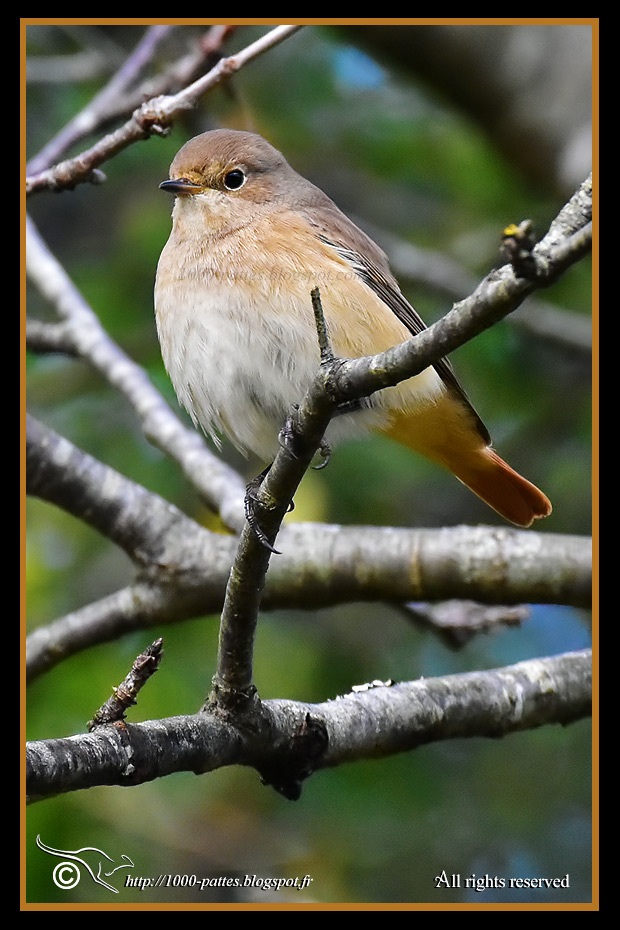Phoenicurus phoenicurus
Passeriformes - Muscicapidae
ou Rossignol de muraille
Le mâle est sans conteste l'un de nos plus beaux passereaux; c'est un insectivore qui chasse depuis un poste élevé et capture ses proies en plongeant et virevoltant un peu à la manière d’un Gobemouche. Il était en compagnie de plusieurs de ces derniers et tout ce petit monde vibrionnait joyeusement comme toutes les fins d'après-midi.
Nicheur dans nos régions, il arrive chez nous fin-avril début mai d'un long voyage qui lui fait traverser le Sahara et la Méditerranée, ce qui cause à l'espèce de lourdes pertes. Pour le moment dans son Statut de Conservation, il est encore classé en "préoccupation mineure" (LC) mais ses effectifs sont en diminution; en cause la sécheresse et la chaleur du désert, la diminution des vergers mais aussi les pesticides répandus en Afrique.
Plus d'infos ICI.
Plus d'infos ICI.
Common redstart
This is not a species I come to see often in my wooded area but I was happy to catch a glimpse of it as I was in hide for mammals at my lake. This insectivorous bird flutters as is feeds, a bit like European Pied Flycatchers with which it was. It arrives in our areas beginning of may from a long trip through the Sahara desert and the Mediterranean sea, causing the species high losses. It is still considered Low Concern (LC) in the conservation Status but high heat in the desert, destruction of orchards and insecticides contribute to numbers plundering.
Ce mâle en plumage nuptial est venu se percher aussi, hélas je n'ai pas pu l'observer longtemps, 3 clics et il s'est sauvé!

This is not a species I come to see often in my wooded area but I was happy to catch a glimpse of it as I was in hide for mammals at my lake. This insectivorous bird flutters as is feeds, a bit like European Pied Flycatchers with which it was. It arrives in our areas beginning of may from a long trip through the Sahara desert and the Mediterranean sea, causing the species high losses. It is still considered Low Concern (LC) in the conservation Status but high heat in the desert, destruction of orchards and insecticides contribute to numbers plundering.
Ce mâle en plumage nuptial est venu se percher aussi, hélas je n'ai pas pu l'observer longtemps, 3 clics et il s'est sauvé!





Lovely pictures. I am not very knowledgeable about Redstarts. When I saw your first three pictures I thought, that isn't the Redstart I know!! I must have only seen, or recognised, males in the past. When my father built his house he had a little hole made in the wall for a Redstart to next. Sure enough it has been occupied each year for the last 12 years. When I visited him on Saturday he told me that it arrives on almost the same day each year!
RépondreSupprimersuch a dear little bird
RépondreSupprimerand you have photographed it beautifully.
such a dear little bird!
RépondreSupprimeryou have photographed it beautifully.
Hello again!:) So glad you saw it to share. Not a bird I see often either, but it's very pretty. Lovely captures, and I especially like the first shot, ..so sweet.
RépondreSupprimerDear Noushka, your photos are gorgeous, what a sweet little bird! :)
RépondreSupprimermignon
RépondreSupprimerEn costume nuptial , il est irrésistible ...
RépondreSupprimerDommage que sa vie soit jalonnée de périodes particulièrement risquées et qu'en plus , il soit aussi menacé à court terme ...
Amitiés .
Another lovely little bird, Noushka. Such little bits of fluff flying so far! Life is getting harder and harder for the many living things we share our world with. I went on a behind-the-scene tour of the entomology department at the Royal BC Museum last week. Scientists there are monitoring insects all over the province. With their short lifespans, they are good indicators of an environment's health, because scientists can follow change through generations. There is no doubt that the climate is changing. Bees are struggling here in BC as well. One priority of the museum is to get its archives above sea level. Many are currently in basement areas which are below sea level. I've been walking all over Washington DC and Victoria BC thinking this will be under water, this will be under water, this will be under water. What is it going to take for people to react at meaningful levels?
RépondreSupprimerAdorable, j'en ai eu une nichée, mais la deuxième a été mangé par un xwxwxs! de je sais pas quoi, un chat peut-être.
RépondreSupprimerPor Madrid se ve mucho en el paso migratorio.. Muy chulas las fotos..
RépondreSupprimerLe mâle est bien reconnaissable, mais la femelle, je me serai peut-être plantée.
RépondreSupprimerTrès belle série, comme toujours.